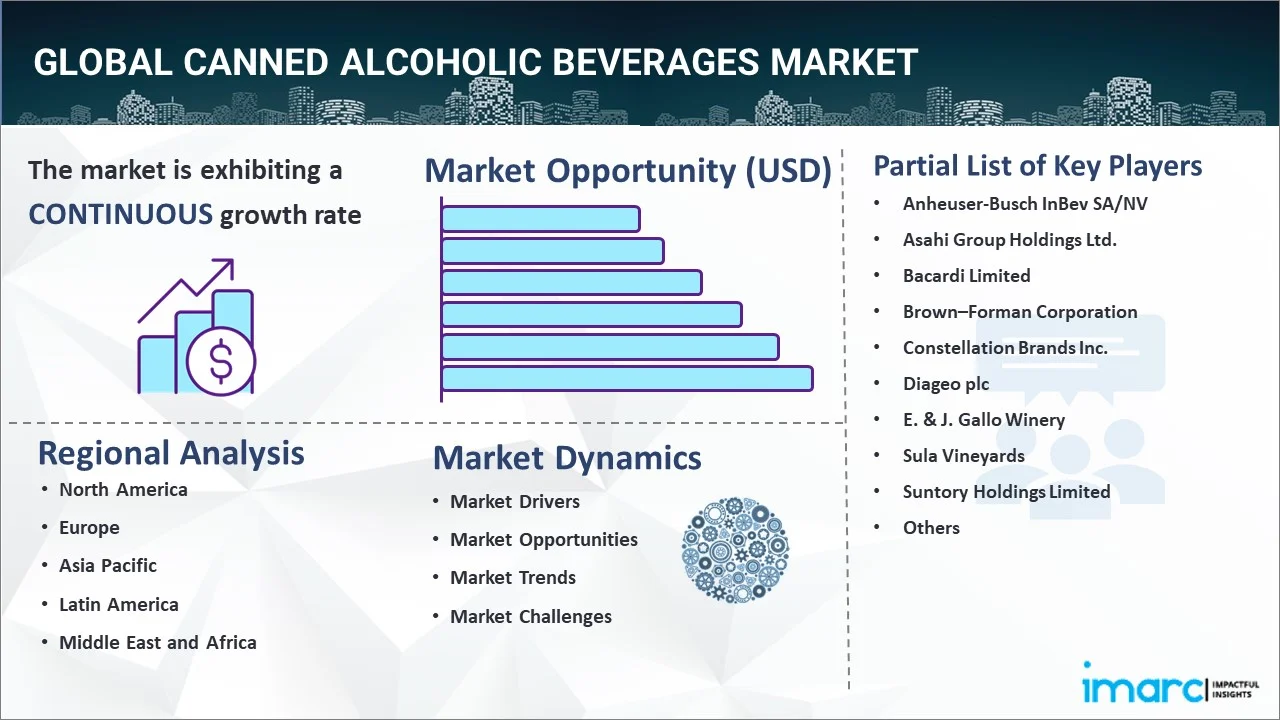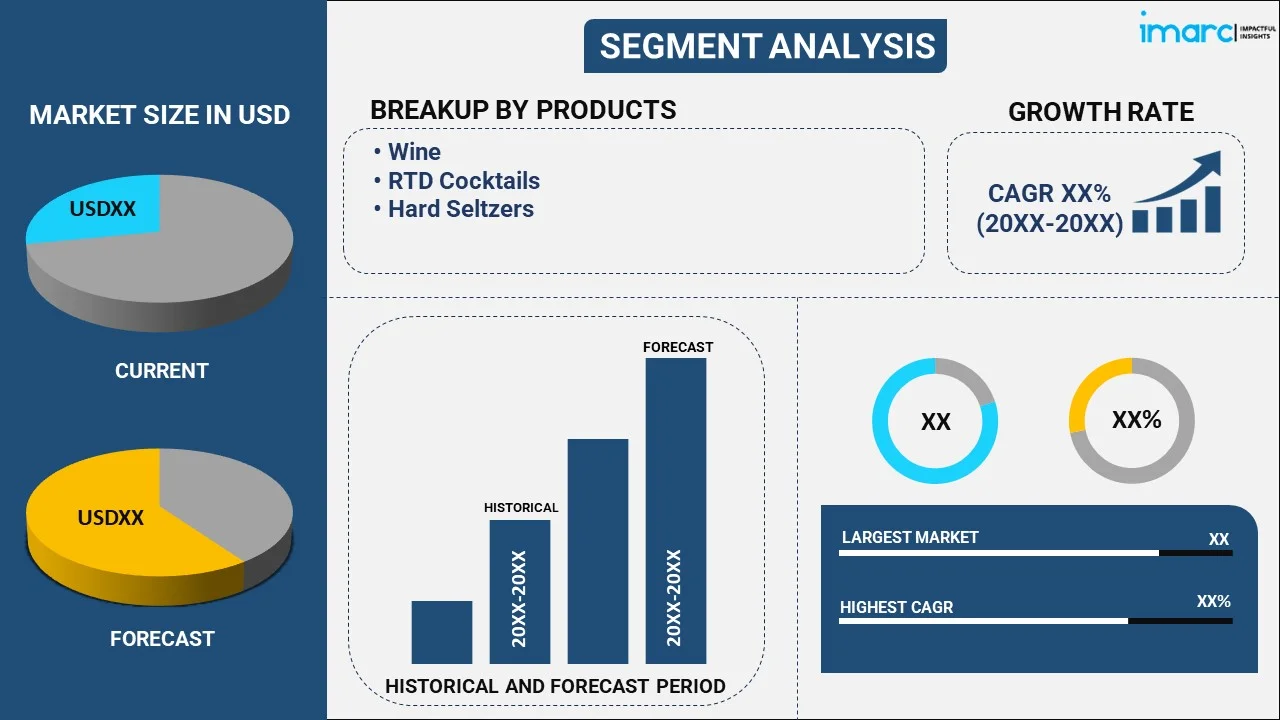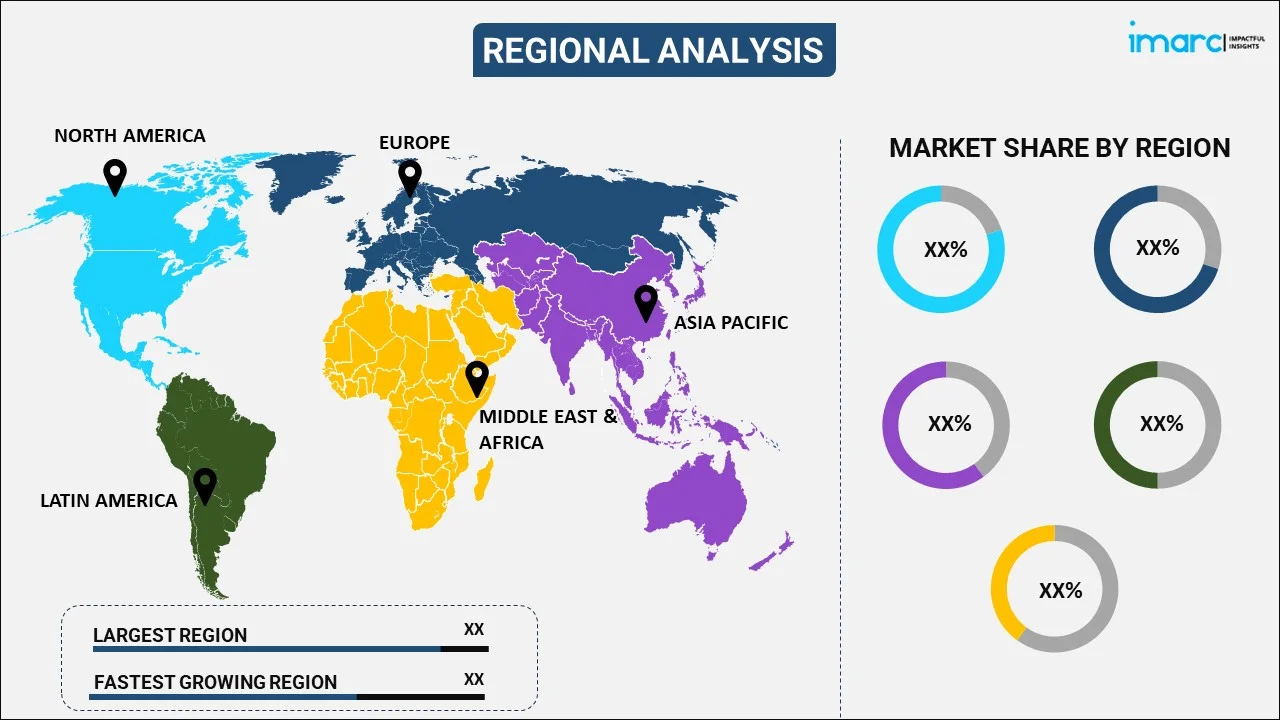
Canned Alcoholic Beverages Market Report by Product (Wine, RTD Cocktails, Hard Seltzers), Distribution Channel (On-trade, Liquor Stores, Online Stores, and Others), and Region 2025-2033
Market Overview:
The global canned alcoholic beverages market size reached USD 141.4 Billion in 2024. Looking forward, IMARC Group expects the market to reach USD 567.5 Billion by 2033, exhibiting a growth rate (CAGR) of 15.2% during 2025-2033. The increasing consumer preference for convenience in ready-to-drink options, shifting consumer behavior towards at-home consumption, continual advancements in canning technology, and an enhanced focus on health-conscious products are among the key factors driving the market growth.
|
Report Attribute
|
Key Statistics
|
|---|---|
|
Base Year
|
2024
|
|
Forecast Years
|
2025-2033
|
|
Historical Years
|
2019-2024
|
| Market Size in 2024 | USD 141.4 Billion |
| Market Forecast in 2033 | USD 567.5 Billion |
| Market Growth Rate 2025-2033 | 15.2% |
Canned alcoholic beverages refer to pre-mixed alcoholic drinks that are sealed in a can for retail distribution. These beverages encompass a wide range of options, from traditional beer and ciders to innovative cocktails and hard seltzers. Characterized by their portability and ease of use, these beverages are formulated to provide a consistent taste experience across multiple settings. The canning process employs sophisticated techniques to ensure product integrity, sealing in flavors and maintaining carbonation. Due to the airtight nature of the can, the beverages are well-protected from external elements such as light and oxygen, which could otherwise degrade quality. Moreover, cans are generally more eco-friendly than glass bottles, offering advantages in terms of recyclability and lightweight for more efficient transportation. In essence, the can serves not merely as a container but as a technology that preserves the quality, taste, and safety of the alcoholic content within.

The canned beverages market size is primarily driven by the increasing consumer preference for convenience in ready-to-drink options. In line with this, continual advancements in canning technology are elevating product quality, thus providing an impetus to the market. Moreover, the prevalence of outdoor activities and social gatherings necessitates portable and easily consumable drink options, acting as a significant growth-inducing factor. In addition to this, elevated levels of disposable income are facilitating consumer access to a broader array of choices, including premium options. Besides this, an expanding retail landscape, both online and offline, is making these beverages more visible and readily available to consumers. Also, the development of niche products targeting health benefits or unique flavors is expanding the consumer base and positively impacting the market. The market is further buoyed by favorable regulations that support the sales and distribution of such beverages. Apart from this, strategic marketing initiatives are succeeding in creating brand awareness and loyalty, thus fueling market growth. Other contributing factors include the growing emphasis on eco-friendly packaging solutions, considerable investments in research and development leading to product innovation, an increasing number of partnerships and collaborations, and the widespread use of digital channels for sales and distribution.
Canned Alcoholic Beverages Market Trends/Drivers:
Shifting consumer behavior towards at-home consumption
The shift towards at-home entertainment and social activities is a pivotal driver in the market for canned alcoholic beverages. This change in consumer behavior can be attributed to a variety of factors, including economic considerations and lifestyle preferences, among others. When consumers opt to socialize or entertain at home, the demand for convenient and easy-to-use products such as canned alcoholic beverages become more pronounced. These products offer the advantage of being easy to store, transport, and serve, making them an ideal choice for at-home settings. Whether it's a casual gathering with friends or a formal event, the convenience of these ready-to-drink options suits the needs of today’s consumer who values both quality and convenience. Moreover, at-home consumption allows consumers to explore a range of products at their leisure, creating an opportunity for brands to introduce sampler packs or limited-edition flavors.
Global expansion of craft beverage makers
Another key driver for this market is the global expansion of small-scale craft breweries and distilleries. These companies offer unique, high-quality beverages that stand out from mass-produced options. As these smaller businesses scale and enter the global market, they often choose to offer their products in canned formats. This strategy not only allows them to participate in a growing market but also helps in attracting a consumer base that values artisanal and specialized options. The inclusion of these craft beverages in the market enriches the overall product range available to consumers and opens up new revenue streams for these smaller enterprises. Furthermore, craft producers often engage deeply with their local communities, creating strong brand loyalty that can translate into broader market success when they expand to other regions or countries.
An enhanced focus on health-conscious products
Health and wellness trends are not confined to the realm of non-alcoholic beverages; they have permeated the alcoholic beverages market as well. Consumers are increasingly seeking options that align with their health goals, whether that means lower calorie counts, fewer artificial additives, or the inclusion of natural ingredients. To meet this rising demand, many producers are launching health-conscious canned alcoholic beverages. These products often come with clear labeling about their nutritional content, empowering consumers to make informed choices. By addressing this growing consumer focus on health and well-being, the industry is not only expanding its consumer base but also adapting to a long-term trend that is likely to persist. These health-conscious products are thus emerging as significant contributors to the overall transformation of the canned alcoholic beverages market outlook.
Canned Alcoholic Beverages Industry Segmentation:
IMARC Group provides an analysis of the key trends in each segment of the market, along with forecasts at the global, regional and country levels for 2025-2033. Our report has categorized the market based on product and distribution channel.
Breakup by Product:

- Wine
- Still
- Fortified
- Low-alcohol
- Sparkling
- RTD Cocktails
- Malt-based
- Spirit-based
- Wine-based
- Hard Seltzers
- Malt-based
- Spirit-based
- Wine-based
The report has provided a detailed breakup and analysis of the market based on the product. This includes wine (still, fortified, low-alcohol, and sparkling), RTD cocktails (malt-based, spirit-based, wine-based), and hard seltzers (malt-based, spirit-based, wine-based).
The wine segment is being driven by the augmenting consumer demand for convenient and portable options. Increased interest in premium and exotic wine varieties is also influencing market growth. In addition, the wine segment is capitalizing on the trend of health-conscious consumption by promoting the health benefits of wine, particularly red wine. Packaging innovations, focused on maintaining the quality and aroma of canned wine, are playing a crucial role. Seasonal promotions and limited-edition releases are being employed to attract new consumers. Marketing campaigns targeting specific demographics like millennials are also contributing to this segment's expansion. Finally, collaborations with influencers and food pairing events are helping to boost the segment’s visibility and market penetration.
On the other hand, the RTD Cocktails segment is benefiting from a rising consumer preference for ready-to-drink options that offer both convenience and a crafted cocktail experience. Innovative flavor profiles and mixology-inspired beverages are attracting younger consumers. The segment is also leveraging premium ingredients to cater to more discerning drinkers.
In addition to this, the appeal of lower-calorie and lower-alcohol options is a primary growth driver for the hard seltzers segment. The segment is witnessing an influx of diverse flavors and formulations aimed at health-conscious consumers. Organic and natural ingredients are being utilized to target a wider customer base. Brand collaborations and co-branding efforts with popular lifestyle brands are helping to increase visibility. Seasonal and event-based marketing strategies are further propelling this segment’s growth.
Breakup by Distribution Channel:
- On-trade
- Liquor Stores
- Online Stores
- Others
The report has provided a detailed breakup and analysis of the market based on the distribution channel. This includes on-trade, liquor stores, online stores, and others.
For the on-trade segment of the global market, factors such as the consumer preference for social drinking experiences, the rising popularity of craft cocktails, and specialized venues are driving growth. The emergence of establishments offering a wide variety of canned alcoholic beverages also adds to the appeal. Live events, tasting sessions, and exclusive launches are frequently hosted by on-trade venues to attract a diverse customer base. Seasonal promotions and loyalty programs further entice patrons to opt for canned alcoholic beverages. These drivers collectively contribute to the sustained growth of the on-trade segment in the global market.
On the other hand, the variety of choices, the convenience of shopping, and the availability of exclusive brands are key growth drivers for the liquor stores segment. Consumers appreciate the ability to explore multiple options in a single location, often aided by knowledgeable staff who can provide recommendations. Promotional offers, bundled packages, and loyalty discounts are additional factors that incentivize purchases. Many liquor stores are also expanding their reach by offering home delivery services. Such strategies are fundamental in bolstering the Liquor Stores segment within the market.
Furthermore, the online stores segment is experiencing growth fueled by the convenience of doorstep delivery, an extensive range of product availability, and user-friendly interfaces. Additionally, online platforms frequently offer exclusive online discounts and the option to subscribe for regular deliveries, making it even more attractive to consumers. The ease of price comparison and the availability of customer reviews also facilitate informed purchasing decisions. Mobile apps and simplified payment methods add another layer of convenience for consumers.
Breakup by Region:

- North America
- United States
- Canada
- Europe
- Germany
- France
- United Kingdom
- Italy
- Spain
- Others
- Asia Pacific
- China
- Japan
- India
- South Korea
- Australia
- Indonesia
- Others
- Latin America
- Brazil
- Mexico
- Others
- Middle East and Africa
The market research report has also provided a comprehensive analysis of all the major regional markets, which include North America (the United States and Canada); Europe (Germany, France, the United Kingdom, Italy, Spain, Russia, and others); Asia Pacific (China, Japan, India, South Korea, Australia, Indonesia, and others); Latin America (Brazil, Mexico, and others); and the Middle East and Africa. North America accounted for the largest canned beverages market share.
In North America, the growing consumption of canned alcoholic beverages is being influenced by a blend of cultural, economic, and social factors. The convenience of canned options appeals to the fast-paced lifestyle of North American consumers. In addition, the region boasts a robust distribution network, including supermarkets, convenience stores, and online retail, which ensures easy availability of these products. Trends like craft beverages and premiumization are particularly influential in driving consumer choices.
Additionally, regulatory frameworks that support the responsible marketing and sale of alcoholic beverages also contribute to a stable market environment. In light of growing environmental consciousness, eco-friendly packaging initiatives are becoming a significant consideration for consumers. Furthermore, demographic factors such as a large millennial population are providing impetus for market growth. Specialized marketing campaigns targeting festivities, sports events, and seasonal occasions are also being deployed to sustain consumer interest throughout the year.
Competitive Landscape:
The key players are actively investing in research and development to introduce innovative flavors and formulations. They are currently expanding their production capacities to meet the growing consumer demand for convenient and portable alcoholic options. Additionally, strategic partnerships and collaborations with distributors and retailers are being pursued to widen market reach. By employing advanced packaging technologies, these industry leaders are working to enhance the shelf-life and appeal of their products. Market frontrunners are also directing efforts towards targeted marketing campaigns that align with the preferences of diverse age groups and cultures. Sustainability initiatives, such as adopting eco-friendly packaging materials, are also underway, signaling the industry's commitment to responsible business practices. To gain competitive advantages, the dominant entities in this market are frequently analyzing consumer behavior and market trends, adjusting their product portfolios accordingly.
The market research report has provided a comprehensive analysis of the competitive landscape in the market. Detailed profiles of all major companies have also been provided. Some of the key players in the market include:
- Anheuser-Busch InBev SA/NV
- Asahi Group Holdings Ltd.
- Bacardi Limited
- Brown–Forman Corporation
- Constellation Brands Inc.
- Diageo plc
- E. & J. Gallo Winery
- Sula Vineyards
- Suntory Holdings Limited
- Union Wine Company
(Please note that this is only a partial list of the key players, and the complete list is provided in the report.)
Canned Alcoholic Beverages Market Report Scope:
| Report Features | Details |
|---|---|
| Base Year of the Analysis | 2024 |
| Historical Period | 2019-2024 |
| Forecast Period | 2025-2033 |
| Units | Billion USD |
| Scope of the Report | Exploration of Historical Trends and Market Outlook, Industry Catalysts and Challenges, Segment-Wise Historical and Future Market Assessment:
|
| Products Covered |
|
| Distribution Channels Covered | On-trade, Liquor Stores, Online Stores, Others |
| Regions Covered | Asia Pacific, Europe, North America, Latin America, Middle East and Africa |
| Countries Covered | United States, Canada, Germany, France, United Kingdom, Italy, Spain, China, Japan, India, South Korea, Australia, Indonesia, Brazil, Mexico |
| Companies Covered | Anheuser-Busch InBev SA/NV, Asahi Group Holdings Ltd., Bacardi Limited, Brown–Forman Corporation, Constellation Brands Inc., Diageo plc, E. & J. Gallo Winery, Sula Vineyards, Suntory Holdings Limited, Union Wine Company, etc. |
| Customization Scope | 10% Free Customization |
| Post-Sale Analyst Support | 10-12 Weeks |
| Delivery Format | PDF and Excel through Email (We can also provide the editable version of the report in PPT/Word format on special request) |
Key Questions Answered in This Report:
- How has the global canned alcoholic beverages market performed so far, and how will it perform in the coming years?
- What are the drivers, restraints, and opportunities in the global canned alcoholic beverages market?
- What is the impact of each driver, restraint, and opportunity on the global canned alcoholic beverages market?
- What are the key regional markets?
- Which countries represent the most attractive canned alcoholic beverages market?
- What is the breakup of the market based on the product?
- Which is the most attractive product in the canned alcoholic beverages market?
- What is the breakup of the market based on the distribution channel?
- Which is the most attractive distribution channel in the canned alcoholic beverages market?
- What is the competitive structure of the global canned alcoholic beverages market?
- Who are the key players/companies in the global canned alcoholic beverages market?
- How big is the canned alcoholic beverage market?
- What is the largest market for alcoholic beverages?
- What is the largest alcoholic beverage company?
Key Benefits for Stakeholders:
- IMARC’s industry report offers a comprehensive quantitative analysis of various market segments, historical and current market trends, market forecasts, and dynamics of the canned alcoholic beverages market from 2019-2033.
- The research report provides the latest information on the market drivers, challenges, and opportunities in the global canned alcoholic beverages market.
- The study maps the leading, as well as the fastest-growing, regional markets. It further enables stakeholders to identify the key country-level markets within each region.
- Porter's five forces analysis assist stakeholders in assessing the impact of new entrants, competitive rivalry, supplier power, buyer power, and the threat of substitution. It helps stakeholders to analyze the level of competition within the canned alcoholic beverages industry and its attractiveness.
- Competitive landscape allows stakeholders to understand their competitive environment and provides an insight into the current positions of key players in the market.
Need more help?
- Speak to our experienced analysts for insights on the current market scenarios.
- Include additional segments and countries to customize the report as per your requirement.
- Gain an unparalleled competitive advantage in your domain by understanding how to utilize the report and positively impacting your operations and revenue.
- For further assistance, please connect with our analysts.
 Inquire Before Buying
Inquire Before Buying
 Speak to an Analyst
Speak to an Analyst
 Request Brochure
Request Brochure
 Request Customization
Request Customization




.webp)




.webp)












